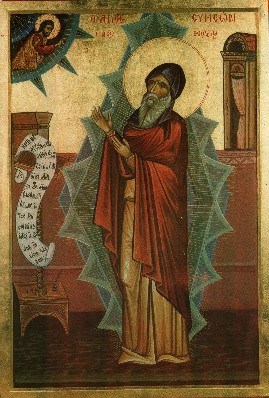St Symeon the
New Theologian (949-1022) was a controversial Orthodox monk and mystic in the
Byzantine Empire. His life was almost coterminous with the reign of the famous
(or perhaps infamous) emperor Basil II, known as the Bulgar-slayer to later
generations. Today, St Symeon has been canonized by the Eastern Orthodox
Church, but this development was by no means obvious during his lifetime.
Indeed, Symeon was suspected of heresy and even banished for a period. Yes, he
was supposedly a “Messalian”…
Hannah Hunt´s
book is frankly boring, but it does give a good introduction to Symeon. Hunt
doesn´t just discuss St Symeon´s mysticism, but also try to place him in proper historical and social context, both as regards Church history and more
broadly within the Byzantine Empire of his time. Thus, we learn that Symeon was
originally a court official, that he had substantial private wealth at his
disposal even as a monk, and that monasteries in Byzantium were often
politically oriented towards wealthy aristocratic patrons. The section on the
role of monasticism within the Empire was interesting, especially since it showed
that the stereotype of the Orthodox monk as a reclusive contemplative is just
that (or perhaps an austere ideal seldom encountered in real life).
Symeon´s
conflicts with Church officialdom were “all the usual ones”. As a strict
ascetic, he naturally came into conflict with all the monks who had joined
the monasteries for other reasons than the strictly spiritual. Indeed, many of Symeon´s monks actually rebelled against his authority and quite literally run away
from the monastery! As a mystic with an intensely personal experience of God,
Symeon de facto rejected Church officialdom, arguing that only
people who had themselves seen God could possibly have authority, including the
power to pardon sins. Symeon the New Theologian´s veneration of his spiritual father (teacher)
Symeon the Studite (in the book referred to as Eulabes) was seen as highly
aberrant by many in the Church. For starters, Eulabes was still alive when
Symeon started to treat him as a saint! The mystic´s main opponent was the rationalist
theologian Stephen the Synkellos, who had the ear of Emperor Basil II himself.
If this sounds
suspiciously similar to the conflicts between Gregory Palamas and Barlaam the
Calabrian 400 years later, well, that´s because the conflict *was* similar. Indeed,
St Symeon the New Theologian is considered a forerunner to hesychasm, or
perhaps even as an early hesychast himself. And yes, the hesychasts too were
inevitably accused of the dread heresy of Messalianism!
Four stars, but
be warned that this is a rather dry scholarly treatise (although perfectly
understandable) of an almost Synkellite quality.

No comments:
Post a Comment